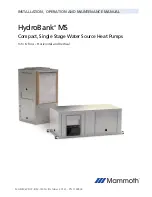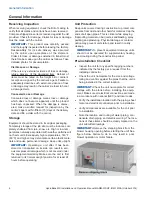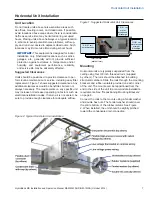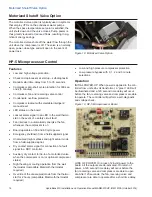
6
HydroBank MS Installation and Operation Manual MAMM-WSHP-IOM-1MSA (October 2014)
General Information
General Information
Receiving Inspection
When receiving equipment, check the Bill of Lading to
verify that all crates and cartons have been received.
Compare shipped-loose items received against the list
provided. Check for damage. Claims for loss or damage
must be made with the carrier.
IMPORTANT:
This product was carefully packed
and thoroughly inspected before leaving the factory.
Responsibility for its safe delivery was assumed
by the carrier upon acceptance of the shipment.
Claims for loss or damage sustained in transit must
therefore be made upon the carrier as follows. Take
detailed photos for documentation.
Visible Loss or Damage
If there is any external evidence of loss or damage,
refuse delivery of the damaged item. Refusal of
items must be noted on the freight bill or carrier’s
receipt, and signed by the carrier’s agent. Failure to
adequately describe such external evidence of loss
or damage may result in the carrier’s refusal to honor
a damage claim.
Concealed Loss or Damage
Concealed loss or damage means loss or damage
which does not become apparent until the product
has been unpacked. When the damage is discov-
ered, make a written request for inspection by the
carrier’s agent within fifteen (15) days of the delivery
date and file a claim with the carrier,
Storage
Equipment should be stored in its original packaging.
Temporary storage at the job site must be indoors, com-
pletely sheltered from rain, snow, etc. High or low tem-
peratures naturally associated with weather patterns will
not harm units. Excessively high temperatures, 140°F
(60°C) and higher, may deteriorate certain plastic mate-
rials and cause permanent damage. Keep units upright.
IMPORTANT:
Operating a unit after it has been
stored or transported on its side can result in seri-
ous compressor damage which is not covered under
the equipment warranty. Make sure the unit is first
returned to its normal upright position for at least 24
hours before operating.
Unit Protection
Keep units covered during construction to protect com-
ponents from dust and other harmful material. Cap the
ends of all open pipes. This is critical while spraying
fireproofing material on bar joists, sandblasting, spray
painting and plastering. Physical damage or contami-
nation may prevent unit startup and result in costly
cleanup.
IMPORTANT:
To prevent equipment damage, units
should not be operated for supplementary heating
and cooling during the construction period.
Pre-installation Checklist
•
Inspect the unit for any specific tagging numbers
indicated by the factory per a request from the
installing contractor.
•
Check the unit nameplate for the size and voltage
rating and confirm against the plans that the unit is
being installed in the correct location.
IMPORTANT:
Check the unit name plate for correct
voltage with the plans before installing the equip-
ment. Make sure all electrical connections are made
in accordance with national (NEC) and local codes.
•
Verify the installation location with the piping, sheet
metal and electrical contractors prior to installation.
•
Verify all clearances are available for the unit prior
to installation.
•
Note the location and routing of water piping, con-
densate drain piping, and electrical wiring. The loca-
tions of these items should be clearly marked on the
unit submittal drawings.
IMPORTANT:
Remove the shipping block from the
blower housing opening before starting the unit! See
figure below. Failure to do so may result in poor
blower operation or motor failure.







































